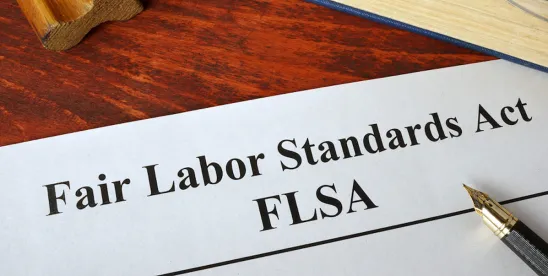On August 23, 2024, the Fifth Circuit Court of Appeals released its long-awaited opinion in Restaurant Law Center v. United States Department of Labor and invalidated the 2021 final tip rule issued by the U.S. Department of Labor (DOL), which restricts when employers can use the tip credit for tipped employees under the Fair Labor Standards Act (FLSA).
Quick Hits
- The Fifth Circuit invalidated the DOL’s 2021 80/20 tip credit rule.
- The rule defined three categories of work and barred employers from taking a tip credit under specified conditions.
- The Fifth Circuit found the rule failed the Administrative Procedure Act “twice over” and is “arbitrary and capricious.”
Tip-Credit Final Rule
The final rule, which was released in October 2021, did two things: (1) defined three categories of work (tip-producing work, directly supporting work, such as side work, and non-tipped work); and (2) if the tipped employee performed directly supporting work for more than 20 percent of the workweek or performed such work for more than thirty consecutive minutes, employers were prohibited from taking a tip credit (i.e., pay a subminimum wage rate of $2.13 per hour and relying on tips to meet its minimum wage obligations) for any time over the 20 percent threshold or thirty-minute threshold. Over the last three years, employers with tipped employees have claimed that the final rule has impeded their ability to operate efficiently.
How We Got Here
In December 2021, the Restaurant Law Center and the Texas Restaurant Association challenged the final rule in the U.S. District Court for the Western District of Texas on grounds that the final rule conflicted with the text of the FLSA and violated the Administrative Procedure Act (APA) and separation of powers. The district court denied the plaintiffs’ request for preliminary injunction, finding that they failed to show they would suffer irreparable harm absent a preliminary injunction. They appealed the ruling to the Fifth Circuit, and on April 28, 2023, the court of appeals reversed the district court, holding that the plaintiffs sufficiently showed irreparable harm in the form of unrecoverable compliance costs. On remand, the district court stood its ground in concluding the final rule was valid. In determining the final rule’s validity, however, the district court heavily relied on the forty-year-old Chevron doctrine of deference to administrative agencies’ reasonable interpretations of federal statutes that were silent or ambiguous as to the specific issue. The plaintiffs appealed again to the Fifth Circuit, and the parties made their oral arguments in April.
Then, on June 28, 2024, the Supreme Court of the United States upended Chevron deference in Loper Bright Enterprises v. Raimondo, holding courts must exercise independent judgment in deciding whether an agency acted within its statutory authority and may not simply defer to agencies’ interpretations of ambiguities in the law. Instead, courts must return to the APA’s basic textual command: “independently interpret[ing] the statute and effectuat[ing] the will of Congress.”
Death of the Final Rule
The court of appeals did not issue a nationwide injunction against the final rule’s enforcement and instead vacated the rule in granting summary judgment.
In its August 23 opinion, a unanimous three-member panel of the Fifth Circuit held that the final rule fails “twice over” under the APA and is “arbitrary and capricious.” At issue in the case was whether the DOL’s conduct was arbitrary and capricious in its interpretation of how a “tipped employee” is defined based on the statutory phrase “engaged in an occupation in which [the employee] customarily and regularly receives more than $30 a month in tips.” The court of appeals held the text “cannot be twisted [by the DOL] to mean being ‘engaged in duties that directly produce tips, or in duties that directly support such tip-producing duties (but only if those supporting duties have not already made up 20 percent of the work week and have not been occurring for 30 consecutive minutes) and not engaged in duties that do not produce tips.’”
The court of appeals explained the final rule is arbitrary and capricious because it considers how a tipped employee’s duties are related to pursuing tips rather than the duties’ relationship to the occupation. By way of example, the court of appeals explained that “[i]f a core duty of a server is bussing and setting up tables, the server is undoubtedly engaged in his occupation. It does not matter whether he is tipped or not for those duties.” The court of appeals further held that the U.S. Congress could not have intended for the tip credit to turn on such fine distinctions between tip-producing and directly-supporting work. The court of appeals stated the final rule unlawfully “replaces the Congressionally chosen touchstone of the tip-credit analysis—the occupation—with one of DOL’s making—the timesheet.”
Looking Ahead
The Fifth Circuit panel made clear that its holding does not impact the validity of the 1967 dual-jobs regulation, which focuses on whether the employee performs tasks unrelated to his or her tipped occupation (for instance, a waitress performing maintenance work). The final rule instead “applie[d] the dual-jobs framework to disaggregate the component tasks of a single occupation” and unlawfully focused on the amount of time spent on those tasks.
The DOL may seek a rehearing from the full Fifth Circuit en banc, or may petition the Supreme Court of the United States to hear the case. But in the meantime, the final rule is vacated.
With the final rule vacated, the rules should revert to the status quo under the Trump administration, which disregarded the 80/20 rule. Employers may want to consider utilizing the DOL’s O*Net database (a tool used by prior administrations), which provides a fixed list of the types of duties tipped employees are required by employers to perform, to ensure the employee is performing duties related to the tipped employee’s occupation. In addition, employers also may still need to consider some state and local laws and regulations that have stricter tip laws than the FLSA. Some states, for example, have their own 80/20 laws that are unaffected by this decision.





 />i
/>i

